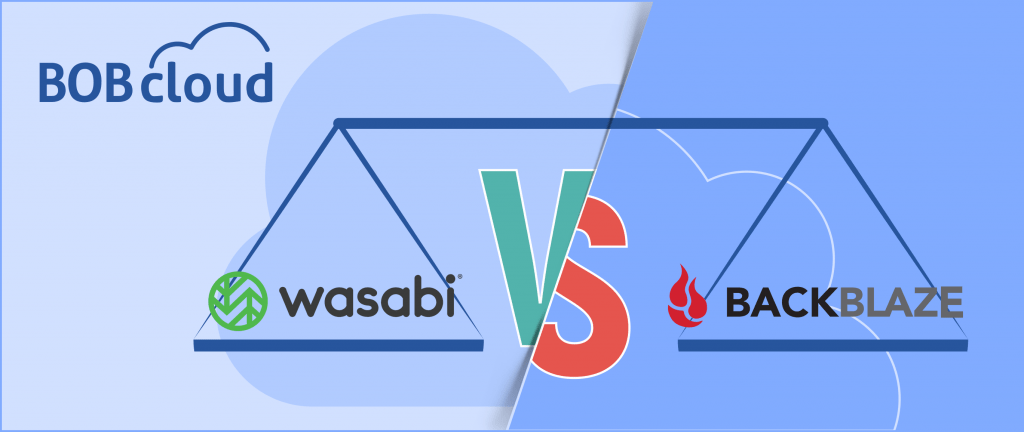What is Object Storage? Read our review of the top 5 players in 2024

Table of Contents
What is Object Storage?
Object storage definition. An object storage system manages data as individual units, called objects, and one file, image, video, etc, can be stored in multiple objects.
Objects are different to standard file-based storage used by Windows, macOS, Linux, etc. Objects are stored in a single location known as an object store and are not sorted into folders.
Each object has its own unique identifier and metadata, which is data that describes the object and allows tracking. Object storage makes spanning data across multiple devices easier and achieves 11 nines of data durability.
Object-based storage has a lower cost of ownership than traditional server and RAID storage.
Object storage benefits:
- Limitless scalability
- Simple to use
- Super-fast searches and data mining
- Resilient and Durable
- Cost-Efficient
B2 Backblaze Pricing Vs Wasabi Storage Pricing. Full comparison, test and benchmark
S3 object storage review
The amount of data your BOBcloud backups generate will grow exponentially in 2023.
Therefore, we have had a quick refresh of the most popular S3 object storage services.
We have been using deduplication since 2021 and continue to improve it. Not only is this technically sensible, but it also reduces restore times (fewer data to download and stitch together) and costs.
Object storage services are now the only cloud storage medium we recommend, and they outclass file storage \ SMB in every aspect.
Object storage offers a cost-effective and highly scalable storage option. In 2023, the best object storage providers offer a combination of features such as scalability, security, ease of use, and affordability.
We have reviewed the top five object storage cloud services in this article and have another article on the top 6 cloud storage providers
Amazon Web Services S3 (Simple Storage Service)
Amazon Web Services S3 (Simple Storage Service) is the most significant player in the object storage market. S3 was the first object-based storage we adopted at BOBcloud.
AWS, like the others in this review, will enable you to grow your object stores seamlessly if your organisation requires big data object storage.
Not only does S3 provide scalability and affordability, but S3 also offers the required levels of security.
These include data encryption in transit and at rest and access controls that can be customised (generally on a role basis).
Rich feature set, never fail storage
Very high data download costs
Microsoft's Azure blobs
Microsoft’s Azure blobs are a very similar offering to S3. Microsoft’s Azure S3 offering is known as Blob Storage and is still an object storage solution. Azure Blob Storage offers identical features to S3, such as scalability, security, and flexibility.
Blobs have 16 nines of data durability achieved with geo-replication and scaled flexibility.
Eleven nines of data durability is considered near zero risk by enterprises, and Microsoft has been ahead of the pack in offering this level of data durability on an object storage system. Wasabi, AWS and Google also provide geo-replications in 2023.
When Azure and AWS landed in the UK within similar timescales, we opted to use Azure. This was because of the simple integration with their compute platform and because they provide the software all our VMs use.
Geo-replication, easy compute integration
Very high data download costs
Google Cloud Storage
Google Cloud Storage is among the top three contenders in the object storage space. It provides scalable and durable storage options, with multiple storage classes to suit various use cases.
Google Cloud Storage also offers advanced features such as automatic data encryption and lifecycle management, making it a secure and efficient option for businesses.
At the time of writing (Oct 2023), Google is offering $300 of free credits so you can test their platform with zero risk to your pocket.
Google has kept up a long tradition of offering plenty of options to Developers, and their S3 object storage doesn’t disappoint. They are offering four flavours so you can enjoy the benefits of object storage no matter your budget.
Standard storage
Use case: ‘Live \ Hot’ critical ‘always on’ data for LOB applications. Perfect for media, websites, streaming, and mobile apps.
Nearline storage
Use case: Lower cost for data that can be stored for 30 days without being accessed.
Coldline Storage
Use case: Lower cost for data that can be stored for 90 days.
Archival storage
Use case: Lowest cost of all for data that can be stored for 365 days. Ideal for backup and data archives.
Flexible storage options
Very high data download costs
Backblaze B2
Backblaze B2 offers an affordable and highly scalable storage solution different from their standard cloud backup service. B2 provides advanced security features, such as two-factor authentication and server-side encryption, making it a secure option for businesses of all sizes.
One of the unique features of Backblaze B2 is its integration with several third-party tools, such as BOBcloud, making it a versatile solution for businesses that require integration with other services.
Zero egress cost*, and low storage cost
Limited features and regions. No geo-replication
Wasabi Hot Cloud Storage
Wasabi Hot Cloud Storage is undoubtedly one of our top tips for an object storage service. Wasabi offers highly scalable and cost-effective storage options with no egress* fees or API request charges.
Wasabi also provides robust security features, including encryption of data both in transit and at rest and access controls that can be customised based on the organisation’s needs.
Wasabi is purely an object storage platform and doesn’t provide compute or any other services you can get from the others in this review.
This works to their advantage because they can focus on being the best they can, and their aggressive low pricing has seen the other big players freeze their prices for years.
Microsoft is not afraid to raise their M365 prices, but they don’t do that with their object cloud storage when Wasabi is growing at an unprecedented rate.
Zero egress cost**, and low storage cost
Limited regions
Conclusion
The best object storage service in 2023 is one that offers a combination of scalability, security, ease of use, and affordability. Amazon S3, Microsoft Azure Blob Storage, Google Cloud Storage, Backblaze B2, and Wasabi Hot Cloud Storage are all strong contenders, each offering unique features and benefits that can make them a good fit for different businesses and use cases.
Amazon S3, Azure Blob Storage, Google Cloud Storage, Backblaze B2, and Wasabi offer robust security features, including data encryption both in transit and at rest and access controls that can be customised based on the organisation’s needs.
Cost is essential for all organisations when choosing an object storage service. Our winner is normally Wasabi, but Backblaze B2 is now on top since they removed their egress charges in the summer of 2023.
They are also the lowest-cost provider and the only one without extra charges.
*Up to 3x of average monthly data stored.
Check Backblaze B2 Object Storage pricing here
**Up to 1x of average monthly data stored.
Timed active and deleted storage costs apply.
Check Wasabi’s Object Storage pricing here


